Immigration Enforcement
Immigration Enforcement (IE) is a division of the Home Office responsible for enforcing immigration law in the United Kingdom. It was established from the section of the former UK Border Agency (UKBA) responsible for enforcing immigration law.
| Immigration Enforcement | |
|---|---|
| Agency overview | |
| Formed | April 1, 2012 |
| Preceding agency | |
| Jurisdictional structure | |
| Operations jurisdiction | United Kingdom |
| Specialist jurisdiction | |
| Operational structure | |
| Elected officer responsible |
|
| Agency executive |
|
| Parent agency | Home Office |
| Website | |
| www | |
History
Former Home Secretary Theresa May announced the abolition of the UK Border Agency on 26 March 2013, with the intention that its work would be returned to the Home Office.[1] The agency's executive agency status was removed and internally it was split, with one division responsible for the visa system and the other for immigration enforcement.[2][3]
Role
Immigration Enforcement is responsible for enforcing the United Kingdom's immigration laws by conducting "visits" to residential and business premises. These visits can often be conducted with a court-issued warrant, in which forced entry may be used if necessary, in order to apprehend immigration offenders. Immigration Officers (IOs) [also referred to as Immigration Enforcement Officers] have a number of powers which allow them to carry out such enforcement work. Whilst on a visit, IOs will question encountered individuals about their immigration status and will arrest anyone found to be in breach of immigration law.
Arrest IOs, for the most part, will not deal with immigration offences as "criminal matters" (seeking to prosecute), unless they are a part of a crime team (see Criminal & Financial Investigation section for more). In the vast majority of cases, a person who has been arrested will be served paperwork notifying them of their imminent removal from the United Kingdom, without any court involvement. This is known as "Administrative Removal" and should not be confused with "Deportation."
IE will often work collaboratively with local councils and transport authorities in order to carry out targeted operations.
Departments
Immigration Enforcement has a number of internal departments, including Criminal & Financial Investigation (CFI) which is a non-uniformed, investigatory unit much like the Criminal Investigation Department within territorial police forces, responsible for investigating criminality surrounding immigration, such as the production of false documents, etc. IE also has its own Intelligence Department, which is responsible for gathering and disseminating information, as well as other functions. Immigration Enforcement has signed up to the Professionalising Investigations Programme (PIP).
The organisation works very closely with other government bodies including police, National Crime Agency, Border Force, UK Visas and Immigration, the National Document Fraud Unit and many more.
Criminal and Financial Investigation
The primary role of the unit is to investigate and disrupt serious organised crime groups who are seeking to undermine the UK's immigration controls at the border and inland via various criminal means. These teams are regionally based and are made up of immigration officers and seconded police officers who work in joint investigation teams as part of the Home Office.
CFI Teams originally started in the UK Border Agency as the agencies own investigation teams, covering both immigration investigations and Customs investigations, mainly drug seizures, that weren't undertaken by the National Crime Agency
Criminal and Financial Investigations (CFI) teams focus on investigating 8 main categories of crime which support other work streams. Those categories include:
1). Trafficking in human beings (THB) and Modern Slavery Act 2015 offences, this could be trafficking for:
- the sex industry
- organ harvesting
- forced labour
- other forms of involuntary servitude
2). Facilitation through:
- lorry drops (clandestine entrants)
- marriage abuse
- college abuse
- rogue employers
- producing or supplying counterfeit or forged documents
- other means
3). Cash seizures of over £1,000 referred from Immigration Compliance and Enforcement (ICE) teams and others, under the Proceeds of Crime Act 2002. [4]
Officers in CFI, who have the same arrest powers as a Police Constable under Section 24 of the Police and Criminal Evidence Act, are required to pass the National Investigators Exam, which has been amended to additionally test Immigration knowledge, before completing the Initial Crime Investigators Development Programme (ICIDP) [PIP 2]. Once officers have completed their portfolio, they are added on to the national Criminal Investigators register and are the equivalent to a Detective Constable but hold a PACE authority of a Detective Sergeant.
Powers
Arrest officers are warranted and derive the majority of their powers from the Immigration Act 1971, although some powers are acquired from the Immigration and Asylum Act 1999 and the UK Borders Act 2007, as well as others.
In the vast majority of cases, Immigration Officers will use "administrative powers" under Schedule 2 of the Immigration Act 1971. Said powers include the execution of warrants and the power of arrest, as well as powers to search arrested persons and to search premises for evidence relating to a person's immigration status (passport, visa, plane tickets, etc.). These powers are used to start a process of "removing" a person administratively - this is often confused with "deportation," which is a different process entirely. Once an IO has arrested a subject, they must seek authority to detain them and serve paperwork upon them. If and when this is granted, authority must then be sought to remove the subject back to their country of origin, possibly through an EU nation or via another transit point. This process ensures that no single officer can remove an individual from the United Kingdom without question - the arresting IO must explain and account for their actions before a CIO / HMI will approve detention and removal. In the event of a senior officer making an arrest, he/she must still obtain authority from another senior officer to detain and serve paperwork.
Others include "28" powers (sections 28A, 28B, 28C, etc.) of the Immigration Act 1971, which are similar to those in Schedule 2, but are criminal powers and not administrative. These are rarely used by standard arrest officers, but still form a large part of an IO's powers. These powers are more likely to be used in cases of "high harm" offenders (individuals involved in criminality) and other cases where a subject is likely to face prosecution (repeat offenders, use of forged documents, etc.).
It is an offence to obstruct or assault an IO. Officers can arrest anyone (including British nationals and EU citizens) if they suspect them of committing such an offence. The powers of arrest are contained within Section 28A(5) of the Immigration Act 1971 and Section 23(1) of the UK Borders Act 2007 respectively.
Since 2013, CFI officers were designated with additional powers to a typical Immigration Officer. These were introduced to increase accountability, and reduce confusion during multi agency working. These powers were added under Police and Criminal Evidence Order (Application to Immigration Officers) 2013. These powers can only be executed for criminal investigations, and by specially trained and designated officers. The PACE order 2013 affords Criminal Investigators the same powers as a constable in relation to arrest, entry and search.
Rank insignia
Uniformed Immigration Officers have their rank displayed on shoulder epaulettes, attached to their wicking shirt, jumper, jacket and stab vest. Officers below HM Inspector rank will usually have their warrant / identification number displayed. Officers possess a warrant card with a crest/badge (akin to police officers), which they may sometimes display in their uniform or plain clothes, if for instance, conducting a raid.[5][6]
The rank structure adopted within Home Office Immigration Enforcement is as follows:
| Immigration Enforcement Ranks | ||||||||||
|---|---|---|---|---|---|---|---|---|---|---|
| Rank | Administrative Assistant | Assistant Immigration Officer | Immigration Officer | Chief Immigration Officer | Her Majesty's Inspector | Assistant Director | Deputy Director | Regional Director | Operations Director | Director General |
| Epaulette Insignia | 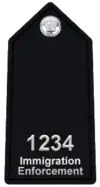 |
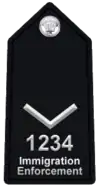 |
 |
 |
 |
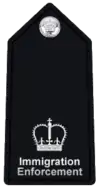 |
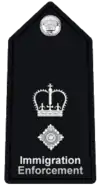 |
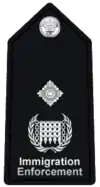 |
 |
 |
There are equivalent grades which mirror the rest of the Civil Service.
The PACE order 2013 introduced that a Chief Immigration Officer is the equivalent to a Police Inspector in relation to lawful authorities. A CIO is also a designated Senior Officer under the Proceeds of Crime Act 2002.
As far as legislation is concerned, there is no difference between an Assistant Immigration Officer and an Immigration Officer. The Home Office has introduced procedural differences. There are differences between the two ranks within Border Force, as only an Immigration Officer has the power to authorise a persons entry/admission in to the UK.
Uniform
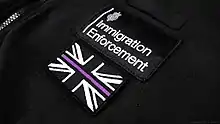
The current uniform for arrest officers includes: wicking shirt, cargo trousers, v-neck jumper, fleece, coat and in some instances a baseball cap. The entire uniform is navy blue. Officers also carry items of Personal Protective Equipment (PPE), including speedcuffs, extendable baton (ASP) and a black stab-proof vest is also worn.
Method of Entry (MoE) officers will usually wear a black boiler suit and protective helmet. These officers have access to a wide array of equipment, allowing them to force entry to premises if required.
In a similar fashion to police officers wearing The Thin Blue Line Union Flag patches, some Immigration Officers wear a Thin Purple Line badge (although not officially part of the uniform). This patch is worn jointly by officers from IE and Border Force, with the colour purple coming from the corporate image of the Home Office. This patch represents the "thin line" of officers protecting the UK's border - the badge can also be used to represent fallen officers, as a mark of respect. Other government services have also adopted this symbolism, for example the Ambulance Service (Thin Green Line) and the Fire Service (Thin Red Line).
Vehicles

Immigration Enforcement teams employ a range of different vehicles. Before the organisation's inception, the previous agency (UK Border Agency) used unmarked vehicles, but a change in policy has led to IE using marked "battenburg" vehicles to improve high visibility, falling into line with the police. The majority of vehicles are vans: Volkswagen Transporters, Mercedes Sprinters and Mercedes Vitos form the majority of the fleet. Some vans contain a cell where detained persons can be placed and safely transported to custody.
Marked vehicles are clearly identifiable by their "battenburg" markings, which are a combination of sky & navy blue chequered squares, surrounded by high-visibility yellow stripes above and below - vehicles also have "Chapter 8" chevrons on the rear. All vans clearly display "Immigration Enforcement" on the front, sides and rear; Home Office logos are also present on each side.
Unlike the police, marked IE vehicles do not have emergency lighting or sirens as the role of an IO does not require them to engage in response driving. However, some marked vans do have flashing "rear reds" which can be used if the vehicle is parked and the driver needs to alert other road users to the vehicle's presence (e.g. if the vehicle is parked on a main road or is a potential hazard).
Since the change to marked vehicles in some instances, IOs have had their vehicles damaged, with tyres slashed and windows broken. The most well-known instance of this was an attack on IOs in Shadwell, East London in September 2015.[10] Whilst IOs conducted a visit to a shop in the area, a number of people attacked their vehicles, resulting in damage to a number of vans and an unmarked car.
Political issues, confrontations & controversy
In 2014, a number of Immigration Enforcement intelligence documents forming part of the "Operation Centurion" campaign were leaked to campaign groups and the media. The information revealed caused controversy, particularly as they gave the impression that operations were widely based on "racial profiling" targeting particular ethnic groups. The then chairman of the House of Commons Home Affairs Committee, Keith Vaz MP, stated that "judging by what I've heard from this document it seems very clear that this is not based on intelligence, but they refer to particular nationalities and particular industries that they are involved in".[7]
A report published in August 2016 by Corporate Watch highlighted a number of areas of controversy surrounding Immigration Enforcement operations against "illegal working".[8] The main points included:
- Racial bias. Workplace raids are massively skewed towards certain ethnic groups; people from India, Pakistan and Bangladesh account for 75% of all those arrested.
- "Low grade" intelligence. While claiming to be "intelligence led", the majority of operations are based on "low grade" tip-offs from "members of the public", classified as "uncorroborated" information from "untested sources" in the official intelligence rating system.
- Entry without warrants. In the majority of raids, Immigration Enforcement teams do not in fact have court-issued warrants. A sample carried out by the Independent Chief Inspector of Borders and Immigration in December 2015 found that teams had warrants in only 43% of cases. In many other raids, Immigration Officers claimed they had "informed consent" to enter premises. But the Inspector noted numerous irregularities in Immigration Officers' understanding of "consent", and that there was no record keeping to actually demonstrate whether or how consent had been given.[9]
- Independent Chief Inspector's criticisms. An earlier 2014 report by the Independent Chief Inspector of Borders and Immigration strongly criticised Immigration Enforcement for entering premises without warrants, including doing so unlawfully, and widely abusing the system of "Assistant Directors' Letters" to enter without due legal process.[10]
- Abuse of "consensual questioning". The Independent Chief Inspector found that, contrary to legal guidance, raid teams routinely round up and interrogate everyone in a premises, whether or not they are a named suspect. They are only supposed to ask "consensual questions" of people who are not named suspects. However, according to the Inspector, “In the 184 files we sampled there was no record of anyone being ‘invited’ to answer ‘consensual questions’. The files showed that officers typically gathered everyone on the premises together, regardless of the information known or people's actions.”[11]
The Corporate Watch report followed the high profile "Byron Burgers Case", where the hamburger restaurant chain collaborated with Immigration Enforcement to set up a "sting operation", calling in workers for early morning meetings where they were met by Immigration Enforcement arrest teams. The Corporate Watch report found that this case was part of a wider pattern in which "Immigration Officers seek to follow up tip-offs by contacting employers and asking them to collaborate ahead of raids. This collaboration may include: handing over staff lists; handing over personal details including home addresses, which are then raided; helping arrange “arrests by appointment”, as in Byron's case and also mentioned in the leaked “Operation Centurion” files."
Immigration is a very political issue within the United Kingdom and this has put Immigration Enforcement at the forefront of issues surrounding migration, refugees and those opposed to immigration law. Many groups, such as "No Borders" and "Anti Raids" are vehemently opposed to the organisation and the way it operates. Groups have called for the public to intervene when IE officers conduct visits.
In some instances, IOs have had their vehicles damaged, with tyres slashed and windows broken. The most well-known instance of this was an attack on IOs in Shadwell, East London in September 2015.[12] Whilst IOs conducted a visit to a shop in the area, a number of people attacked their vehicles, resulting in damage to a number of vans and an unmarked car.
Public Accounts Committee Report
In September 2020, the Public Accounts Committee published a report that was highly critical of the IE. The Committee found that Home Office had "no idea" what the IE unit had achieved since being established. The Committee also found that officials were reliant on "disturbingly weak evidence" when assessing the efficacy of immigration enforcement policies. The report warned that there was a risk that the IE's policy decision were based purely on "assumption and prejudice" and concluded that a lack of diversity among senior management risked a repeat of the Windrush scandal.[13]
References
- "UK Border Agency 'not good enough' and being scrapped". BBC News. 26 March 2013. Retrieved 19 March 2014.
- "UK Border Agency's transition to Home Office". UK Border Agency. 3 May 2013. Archived from the original on 16 June 2013. Retrieved 12 May 2013.
- https://www.gov.uk/government/news/uk-border-agency-to-split-into-two-new-groups
- https://www.gov.uk/government/uploads/system/uploads/attachment_data/file/584221/Criminal-investigationsv1_0_ext.pdf
- https://ichef.bbci.co.uk/news/1024/media/images/76601000/jpg/_76601541_tv023335863.jpg
- https://www.freemovement.org.uk/wp-content/uploads/2016/08/11436772514_e1e450e6c3_b.jpg
- "Migrants Rights Network Operation Centurion Keith Vaz".
- "Snitches, Stings & Leaks: how Immigration Enforcement works | Corporate Watch". corporatewatch.org. Retrieved 1 October 2016.
- "ICIBI Report on Illegal Working Operations December 2015" (PDF).
- "ICIBI report "AD letters" and Immigration Enforcement entry without warrants" (PDF).
- "ICIBI Report on Illegal Working Operations December 2015" (PDF).
- "Home Office immigration vans 'had tyres slashed in east London'". Evening Standard. 26 July 2015. Retrieved 21 January 2020.
- Casciani, Dominic (18 September 2020). "Home Office immigration unit has 'no idea' - MPs". BBC News. Retrieved 18 September 2020.
.svg.png.webp)